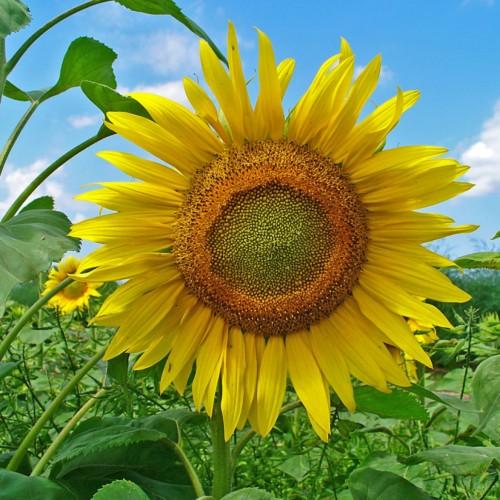
sunflower
Helianthus annuus cvs.
Cycle:
Perennial
Watering:
Frequent
Hardiness Zone:
5
Flowers:
Flowers In Autumn
Sun:
part sun/part shade,filtered shade
Soil:
Rocky , gravelly , dry, Well-drained
Fruits:
Fruits In Spring Ready In Fall
Leaf:
Yes
Growth Rate:
High
Maintenance:
Moderate
Poisonous To Pets:
Yes
Drought Tolerant:
Yes
Salt Tolerant:
Yes
Indoors:
Yes
watering
For the variegated Persian ivy, the general rule of thumb is to water when the top inch or 2 of soil is dry. Depending on the season and your plant's environment, this may mean watering once or twice a week in summer and every 7 to 10 days during the cooler months. It's important to give your ivy enough water so that it doesn't dry out and stress the plant but don't over water as this may cause root rot. If you're uncertain, work your finger into the soil to determine if it needs water. Ideally, you should aim to water your variegated Persian ivy deeply in order to promote strong root growth and a healthy foliage.
sunlight
Variegated Persian ivy prefers a location with bright, indirect sunlight. This species needs at least 4-6 hours of sun exposure daily, but more may be required during the summer months. It may be beneficial to provide shade to protect the plant from intense midday sun, especially in zones 9 and higher. During the winter months, it is best to provide your Variegated Persian ivy with a bright but cool window with plenty of natural indirect light.
pruning
Variegated Persian ivy (Hedera colchica 'Sulfur Heart') should be pruned once every year in late winter or early spring before the growth period begins. The necessary amount of pruning depends on the size and condition of the plant. Start by removing any dead or diseased branches to improve the appearance and health of the plant. Then, trim the branches to maintain the desired shape and size of the plant. To maintain the shape and color of the variegation, avoid pruning more than 10-15% of the foliage at once. Finally, be sure to sterilize cutting tools between branches when possible to reduce the risk of spreading diseases.
Propagation
Season
Hardiness Map
FAQ
Are sunflower seeds edible?
Yes, sunflower seeds are edible and are enjoyed around the world. Sunflower seeds have a nutty flavor and can be eaten either raw or roasted. Popular forms of eating sunflower seeds include tossing them in salads, sprinkling them in stir fry dishes, using them as an ingredient in baked goods, and snacking on them as a healthy and tasty snack. Sunflower seeds are available both with and without their shells, depending on the preference of the consumer.
Are there any pests that commonly attack sunflowers?
Yes, there are several pests that commonly attack sunflowers, such as European corn borer, aster leafhoppers, cabbage loopers, and potato leafhoppers. These pests can all cause significant damage to the plant, such as wilting of the leaves, stunted growth, and loss of petals. Preventative measures, such as proper maintenance and pesticides can help reduce their numbers and damage to the sunflowers.
Are sunflowers an annual or perennial plant?
Sunflowers are an annual plant, meaning they will only live for one growing season. This typically falls within the summer months as sunflowers will reach maturity within two to three months after planting. They will typically flower and then die off before the following season, making them an annual plant.
Could sunflowers grow in a greenhouse or indoor garden?
Yes, sunflowers can be grown in a greenhouse or indoor garden. Sunflowers require bright, direct light, but if a greenhouse or indoor garden is equipped with special lighting, sunflowers can grow successfully. When growing them indoors, it is important to ensure that the soil is well-drained and that they are getting the appropriate amount of light, water and nutrients. When the conditions are right, even the tallest varieties of sunflowers can be successfully grown indoors.
Should sunflowers be planted in the spring or fall?
Sunflowers should be planted in the spring, as soon as the last frost has passed and the soil is warm. Planting in the spring ensures that your sunflowers get plenty of heat and sunshine to spur growth and yield beautiful blooms. In more northern climates, however, you might need to stagger your planting dates over the spring so that they are not all exposed to extreme cold.
How long does it take for a sunflower to bloom?
Sunflowers have a relatively short blooming season, typically lasting only a few weeks. After pollination, the flower buds will typically form within 5-10 days and open up within 8-12 days. This means a sunflower can take anywhere between 8 and 20 days to bloom after pollination. Factors such as genetics, soil temperature, and light availability can influence the amount of time it takes a sunflower to bloom.
Do sunflowers attract bees and butterflies?
Yes, sunflowers are very attractive to bees and butterflies. Sunflower petals offer a generous amount of nectar, providing an excellent food source for these pollinators. Sunflowers also offer protection from predators and the elements for the bees and butterflies. The bright yellow color of the sunflower petals are also visually appealing to these insects, drawing them in from miles away!
Is the sunflower a symbol of happiness?
The sunflower is often associated with happiness and joy, usually because of its bright yellow petals and attractive appearance. Sunflowers can also be seen as symbols of loyalty and warmth, as they have a tendency to always follow the sun and turn towards the light. The sunflower is often used as a representation of faith or loyalty, and its natural beauty can provide us with a sense of joy and optimism.
